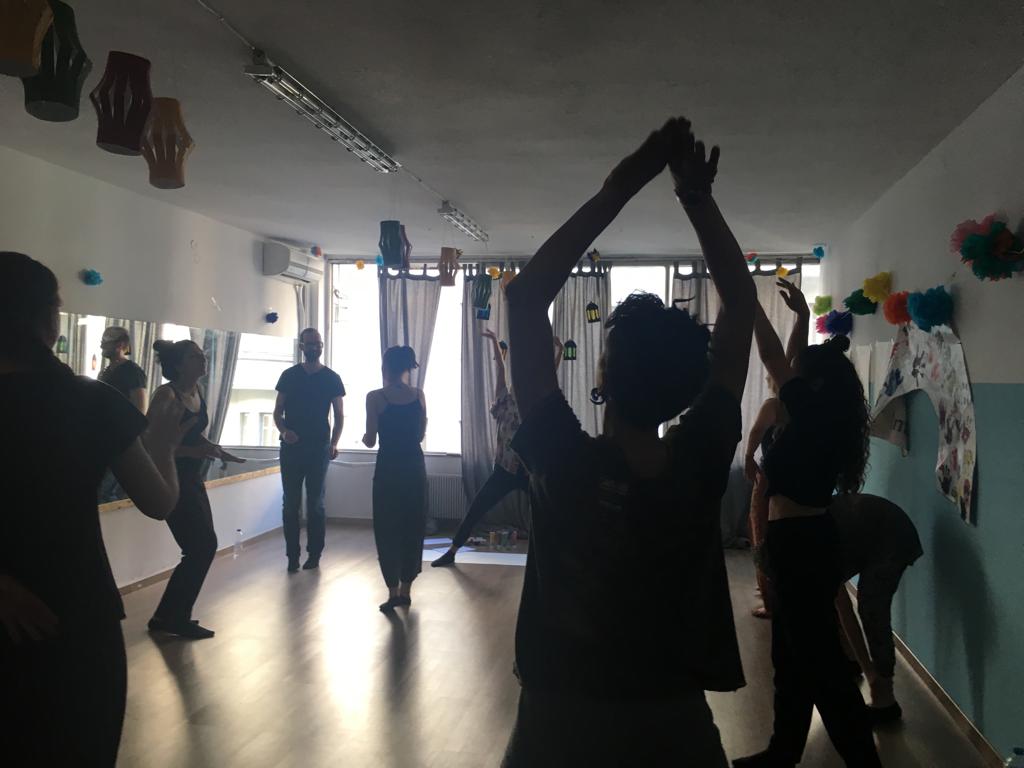
Courtesy of Amna
[ID: A group of women participating in Dinami, Amna’s youth program, stand in a circle on a dirt path in a forest. They stand tall with their arms reaching up. They are all dressed casually.]
We are born to move. Every heartbeat and every breath we take from the moment we enter the world activates and settles our bodies. In trauma-informed practice, including somatic body work and dance and movement therapy, we learn how to awaken our bodies and emotions when they’ve become shut down, and how to settle our system when it has become overwhelmed.
We’re born to move, but how we move is dependent on us as individuals and our circumstances.
War is dislocating
Amna is an organization dedicated to supporting the psychosocial wellbeing of refugees and other displaced communities. Our story began in 2016 on the border of Greece and North Macedonia where thousands of refugees had become stranded. We set up a tent and started providing therapeutic group sessions for men, women and children who experienced violence, displacement and torture. As refugees continued to arrive, we grew to meet the need of displaced communities in Greece. We worked in camps and community centres with refugees and psychosocial experts to develop our current programming – nonclinical community-based interventions that help people who have experienced violence and forced displacement feel safer again.
100 million people are forcibly displaced around the world,[1] a new and grim record. Those who are forcibly displaced are more likely to suffer from PTSD, depression and anxiety symptoms.[2] Throughout their displacement and journeys to safety, refugees are repeatedly traumatised and retraumatised. The compounding layers of stress experienced through living in a war zone, having to make the decision to leave your home, country and loved ones, unknown perilous journeys and hostile experiences in transit and host countries, can result in trauma responses that leave refugees feeling unsafe in their own bodies.
Trauma can impact our ability to cope with daily life even when in a relatively safe environment. This is because, unless it’s released, trauma can continue to live on in our bodies following a traumatic event, causing a part of us to remain in the past, reliving fear and our trauma response. Without the right support, refugees can live with unprocessed trauma throughout their lives. Joy, playfulness, creativity and confidence can become casualties to trauma. People may feel an injured version of themselves even after they’ve arrived in a place of relative safety. We saw this clearly through the stories told in our SADA storytelling project – the emotional impact of displacement is huge and so often misunderstood.
Reconnecting and releasing through movement

[ID: A woman is silhouetted in a dimly lit room that has a mirror on one wall, partially covered windows, and colorful decorations on the walls and ceiling. Her arms are raised in a diamond shape as she moves her body. Additional people move around the room.]
At Amna, dance, movement and working with rhythm are some of the psychosocial tools we use, and train others to use, to promote healing from trauma. Marianna is a freelance Dance Movement Therapist and former Amna facilitator and Gabriella is Head of Programmes at Amna. Together, we’ve seen the dislocating impact that war and displacement can have on people’s bodies. Many of the communities we’ve worked with describe pains in their bodies, a somatisation of the grief and loss they continue to experience. The field of epi-genetics research shows that our memories and experiences are stored in every cell of our body and can be passed across generations.
Movement practices have long been recommended to help deal with psychological challenges. Exercise can release serotonin, a mood ‘stabiliser’ or so-called ‘happy chemical’. Moving in communities – whether dancing, drumming, or group bonding activities involving movement in a collective – are practices that promote expression, connection, release and often processing. In many parts of the world, movement, music and rhythm are a part of celebration and grief rituals in births, weddings and funerals.
Movement therapy can help people connect to, make sense of, and express memories and experiences held in their bodies, helping the body release what is no longer useful. It can help us regain a sense of control, feel seen and recognised, relax, have fun, play and practice ways to ground ourselves when we feel overwhelmed or triggered. All of these experiences can help the mind and body to heal.
While movement of all forms can help people, Dance Movement Therapy is a specific form of movement therapy that is often used at Amna. We work with groups including teenagers, women, men and children, for short or long term interventions, creating a safe space where people can communicate, express themselves and heal. The precise tools and ways practices are engaged with is unique in response to the group’s needs, abilities and desires, and how they shape the process and respond to the medium. Dance Movement Therapy is a practice that is built around each participant/client and/or group, with respect to each person’s individuality and the collective.
Building trust through shared power
Dance Movement Therapy has no end goal in terms of learning steps or improving technique. It is very much guided by the group with a big focus on building trust and a safe environment. A therapeutic contract and guiding rules for the space are agreed on from the beginning by the whole group, including the therapist. These are not static but change as the group evolves. There is no classic hierarchy of the teacher and their students, everyone is equal including the therapist. Power dynamics are a particularly important aspect of Amna’s identity-informed approach which underpins all our work.
All sessions begin with a check in to see what energy, feelings and emotions participants are bringing to the space. It can be verbal or use movement as well. Then, depending on the responses, the therapist invites engagement through movement activities. Group members always have a choice about how and if they participate. The group also has freedom to use the space with little intervention from the therapist and are invited to improvise, play, dance, move together and explore how and what they need, being led by their bodies. The sessions close with a check out, an opportunity to reflect and give meaning to what happened during the session, verbally, through art or through movement again. The therapist is there to support without making their own interpretations or judgements.
Recovering confidence and reshaping lives
Dance Movement Therapy can be a powerful tool for healing. Our bodies are affected by our experiences even if we are not conscious of it. In our experiences running Dance Movement Therapy groups, we’ve seen groups have moments of intense expression emotionally, mentally and physically as they process emotions that were hidden deep inside themselves. When these experiences can be safely held by the group with the support of the therapist, group members often leave the session feeling a sense of release, reporting feeling lighter emotionally and physically, with more clarity of mind and openness in their bodies.
In one session we used movement to explore strength and vulnerability. Together we connected with each part of our body to understand what it means to be strong in our legs, our feet, our hands and so on. We ended in a pose that we called our ‘statue of strength’. It was a breakthrough session for one of our group members who began to find clarity in the different meanings of strength and the expectations that she had attached to strength. She shared that she felt she had lost her confidence and through this exercise was able to start reconnecting with her body and mind. We continued working with her to explore how to incorporate this in her everyday life, through ‘confident’ poses and other ways she can bring this sensation into her body.
Everything in life is movement. Our bodies are always moving, even when we think we are still, our organs and breath continue moving and keep us alive. We’re born to move but how and where is dependent on each person and community. That’s why Dance Movement Therapy must also be used with respect to the uniqueness of each person’s pace, particular needs and circumstances. Amna means “safe and caring” in Arabic. We believe, when worked with in a safe and caring, trauma-sensitive and identity-informed way, the impact of Dance Movement Therapy can be life-changing.
[1]https://www.unhcr.org/news/press/2022/5/628a389e4/unhcr-ukraine-other-conflicts-push-forcibly-displaced-total-100-million.html
[2]https://www.who.int/news-room/fact-sheets/detail/mental-health-and-forced-displacement
Gabriella Brent is Amna’s Head of Programmes and a transpersonal counsellor and psychotherapist. She oversees Amna’s training and capacity strengthening programmes; Baytna, Dinami, therapeutic work with men and women and Amna’s humanitarian wellbeing capacity-building work – providing training and wellbeing support to other humanitarian organisations working with refugees. Before working with Amna, Gabriella worked across the UK piloting and implementing more humane and trauma-informed models of care.
Marianna Fiotaki is a freelance Dance and Movement Therapist. She runs psychosocial and healing groups for youth and women and is passionate about developing psychosocial support spaces in respectful, equitable contexts, where the community is the central agent and holds the power. She has worked with groups at risk of social exclusion in various settings, from daycare centres to hospitals. Marianna is currently studying Existential Psychotherapy and has a Master’s degree in Dance Movement Therapy.


